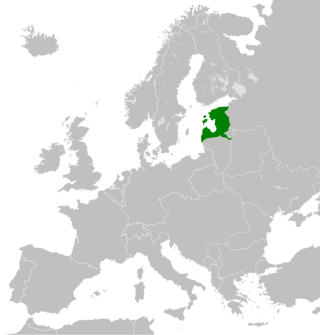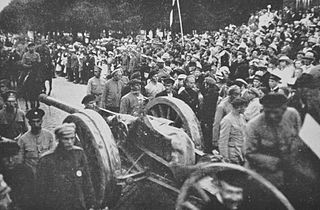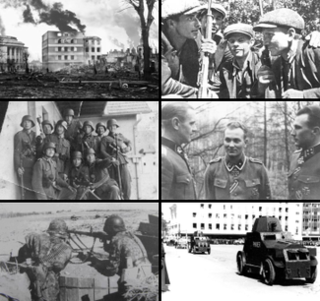
The United Baltic Duchy, or alternatively the Grand Duchy of Livonia, was the name of a short-lived state during World War I that was proclaimed by leaders of the local Baltic German nobility.

The Estonian War of Independence, also known as the Estonian Liberation War, was a defensive campaign of the Estonian Army and its allies, most notably the United Kingdom, against the Soviet Russian westward offensive of 1918–1919 and the 1919 aggression of the pro–German Baltische Landeswehr. The campaign was the struggle of the newly established democratic nation of Estonia for independence in the aftermath of World War I. It resulted in a victory for Estonia and was concluded in the 1920 Treaty of Tartu.

Nikolai Nikolayevich Yudenich was a commander of the Russian Imperial Army during World War I. He was a leader of the anti-communist White movement in northwestern Russia during the Civil War.

The Soviet westward offensive of 1918–1919 was part of the campaign by Soviet Russia into areas abandoned by the Ober Ost garrisons that were being withdrawn to Germany following that country's defeat in World War I. The initially successful offensive against the Republic of Estonia ignited the Estonian War of Independence which ended with the Soviet recognition of Estonia. Similarly, the campaigns against the Republic of Latvia and Republic of Lithuania ultimately failed, resulting in the Latvian–Soviet Peace Treaty and Soviet–Lithuanian Peace Treaty respectively. In Belarus, the Belarusian People's Republic was conquered and the Socialist Soviet Republic of Byelorussia proclaimed.

The Battle of Narva was a World War II military campaign, lasting from 2 February to 10 August 1944, in which the German Army Detachment "Narwa" and the Soviet Leningrad Front fought for possession of the strategically important Narva Isthmus.
Battle of Narva may refer to:

The Latvian War of Independence, sometimes called Latvia's freedom battles or the Latvian War of Liberation, was a series of military conflicts in Latvia between 5 December 1918, after the newly proclaimed Republic of Latvia was invaded by Soviet Russia, and the signing of the Latvian-Soviet Riga Peace Treaty on 11 August 1920.

Estonia declared neutrality at the outbreak of World War II (1939–1945), but the country was repeatedly contested, invaded and occupied, first by the Soviet Union in 1940, then by Nazi Germany in 1941, and ultimately reinvaded and reoccupied in 1944 by the Soviet Union.
The Battle of Cēsis, fought near Cēsis in June 1919, was a decisive battle in the Estonian War of Independence and the Latvian War of Independence. After heavy fighting an Estonian force moving from the north, supplemented by Latvian units, repelled Baltic German attacks and went on full counter-attack.

The Kuperjanov Infantry Battalion is a battalion of the Estonian Land Forces. It is a part of the 2nd Infantry Brigade. Battalion headquarters is at Taara Army Base, Võru.
The Tallinn offensive was a strategic offensive by the Red Army's 2nd Shock and 8th armies and the Baltic Fleet against the German Army Detachment Narwa and Estonian units in mainland Estonia on the Eastern Front of World War II on 17–26 September 1944. Its German counterpart was the abandonment of the Estonian territory in a retreat codenamed Operation Aster.

Battle of Auvere took place in Estonia, starting on July 20, 1944 and ending on July 25. It was a part of the World War II campaign in Narva.

This is a sub-article to Leningrad–Novgorod Offensive and Battle of Narva.

This is a sub-article to Battle of Narva (1944).

The Narva offensive was an operation conducted by the Soviet Leningrad Front. It was aimed at the conquest of the Narva Isthmus from the German army detachment "Narwa". At the time of the operation, Joseph Stalin, the supreme commander of the Soviet Armed Forces, was personally interested in taking Estonia, viewing it as a precondition to forcing Finland out of the war.

This is a sub-article to Battle of Narva.

This is a sub-article to Battle of Narva (1944).

The Northwestern Army was a White Army that operated in the Pskov Governorate, Saint Petersburg Governorate, Estonia and Latvia during the Russian Civil War from 1919 to 1920.

The 7th Army was a field army of the Red Army during the Russian Civil War, which existed between November 1918 and February 1920.

The Walk Crisis was an episode in Estonia–Latvia relations over the territorial dispute along the border between the two countries, chiefly about the town of Walk and the island of Runö. The territorial dispute lasted from 1918 when both countries declared independence, until its settlement in a border treaty in October 1920.













